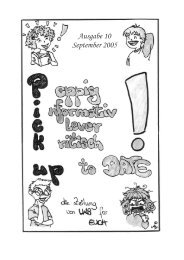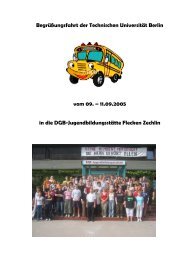Elegantes Telefax - JAV der TUB - TU Berlin
Elegantes Telefax - JAV der TUB - TU Berlin
Elegantes Telefax - JAV der TUB - TU Berlin
Create successful ePaper yourself
Turn your PDF publications into a flip-book with our unique Google optimized e-Paper software.
3<br />
formance gap. Consi<strong>der</strong>able attention has gained the question related to environmental<br />
performance as a result of environmental policy changes in the World Bank,<br />
but the question has not been applied to the water resources sector of the Bank.<br />
This article raises the question how the World Bank has developed and adopted<br />
the concept of Integrated Water Resource Management and the question whether<br />
and if yes to what extent the water policies of the World Bank have changed in the<br />
first half of this decade towards a more infrastructure-building orientation and how<br />
these changes can be explained. Here, the article employs the analytical concept of<br />
the principal-agent relationship to which the environmental NGOs play the role of a<br />
lobbying third party. The adoption of IWRM has to be seen in the context of the overall<br />
integration of environmental consi<strong>der</strong>ations in the lending activities of the World<br />
Bank. Because of the prominent role of dams as a focusing type of project for NGO<br />
campaigning against the environmentally damaging effects of World Bank lending,<br />
the position of the World Bank on lending for dams is an import indicator for policy<br />
changes. While the research on the environmental policies of the World Bank in general<br />
moves on the question of measuring and explaining the effectiveness of these<br />
policies, this article focuses on the content and process of various policy formulations<br />
which are important for water resource management: Two internally controlled processes,<br />
resulting in the Water Resources Management Policy Paper in 1993 and the<br />
2004 Water Resources Sector Strategy are contrasted to the Bank assisted, but external<br />
process of the World Commission on Dams. Here, the question is pursued to<br />
what extent and by what means NGOs managed to influence the policy formulation<br />
process.<br />
The article starts with the description of the analytical framework, the principalagent<br />
model, and then it surveys the literature applying the model to international<br />
organizations in development cooperation. Here, the specific features of the delegation<br />
chain between the taxpayer in donor countries at the beginning and the beneficiaries<br />
in the borrowing countries at the end are analyzed and how these features and<br />
the attempts of the principals to control their agents influence aid delivery. This process<br />
of a delegating in multiple steps results in an unavoidable degree of agent slippage<br />
which is consi<strong>der</strong>ed to be the price to be paid for the delegation by the principal.<br />
The analytical framework is then applied to the analysis of the governance of the<br />
World Bank. Here, the issue of the relative autonomy of the World Bank as an agent<br />
is raised based on the high share of refinancing by international capital markets and<br />
the specific mechanisms to control and influence the World Bank as an agent are<br />
analyzed. Next, the paper summarizes the (empirical) research about the inclusion of<br />
general environmental objectives into the governance of the World Bank and the mechanisms<br />
employed to bring about this change of behavior of the World Bank.





